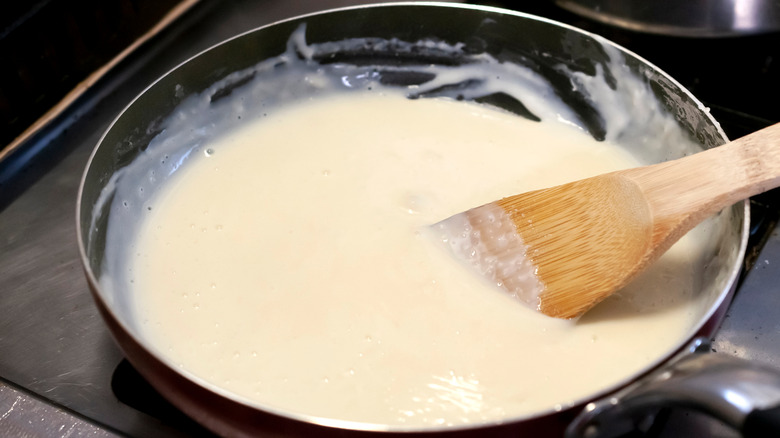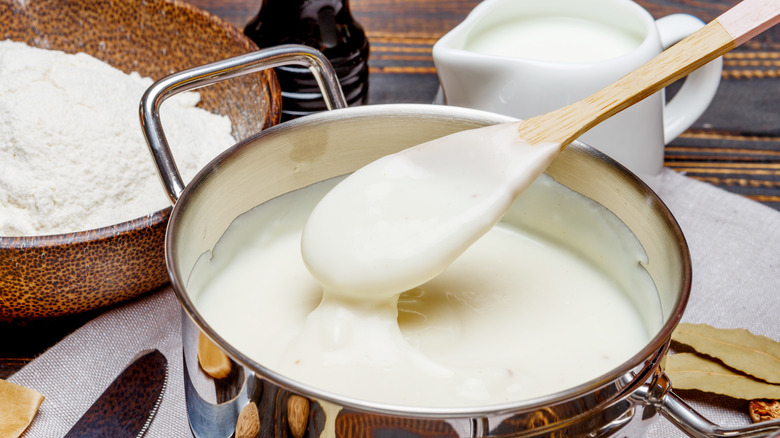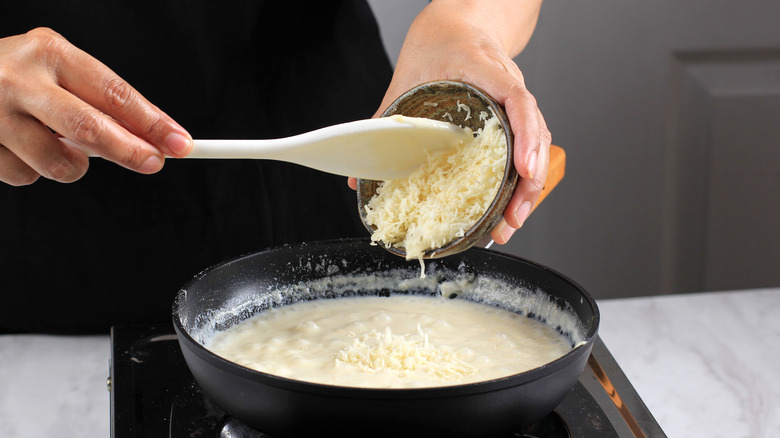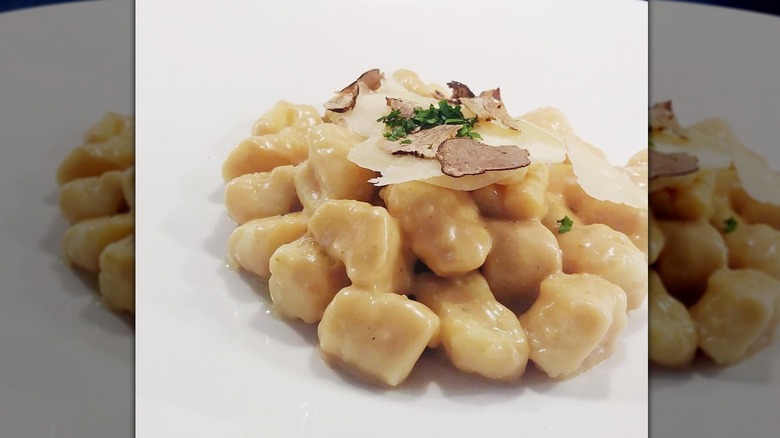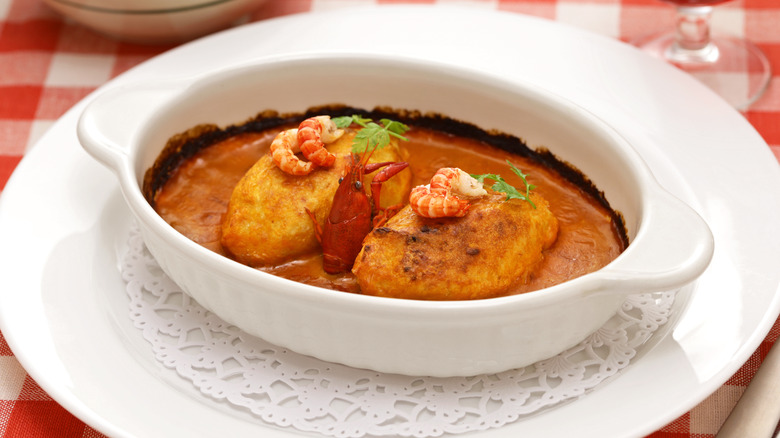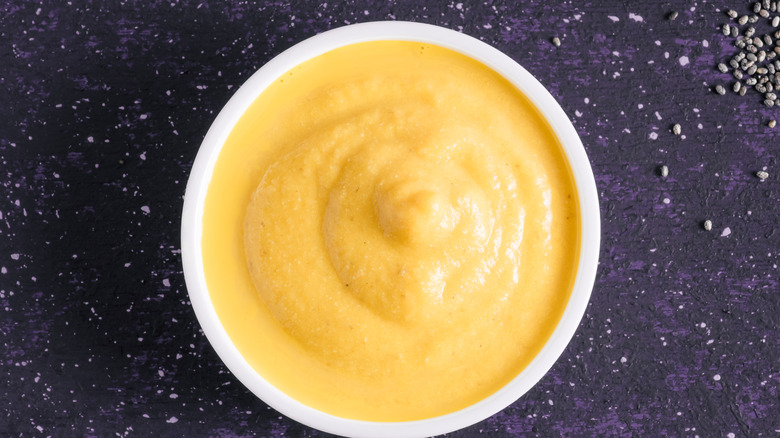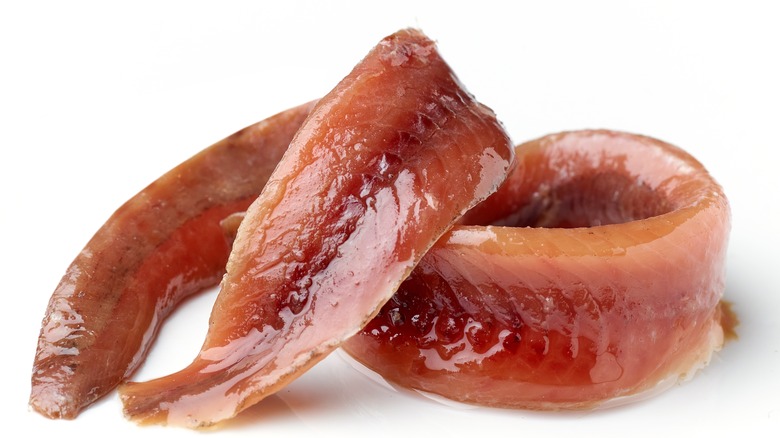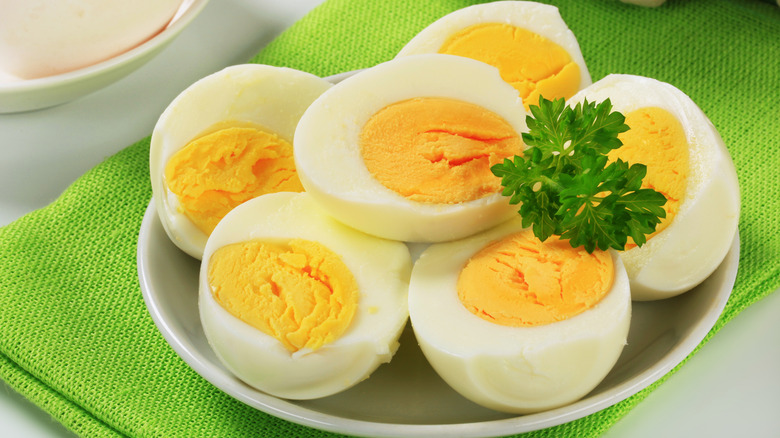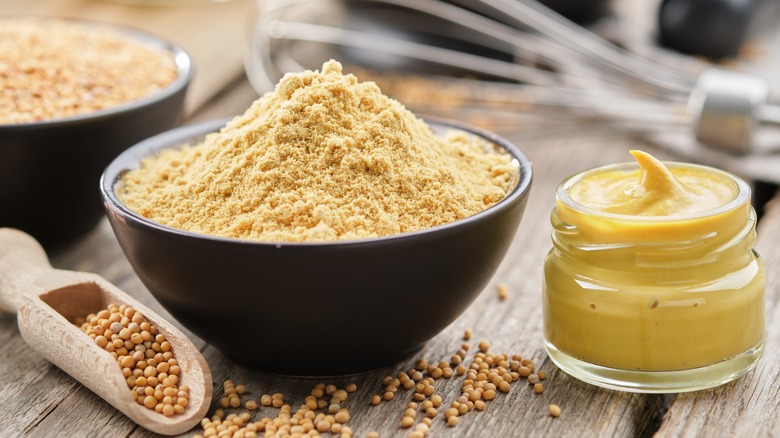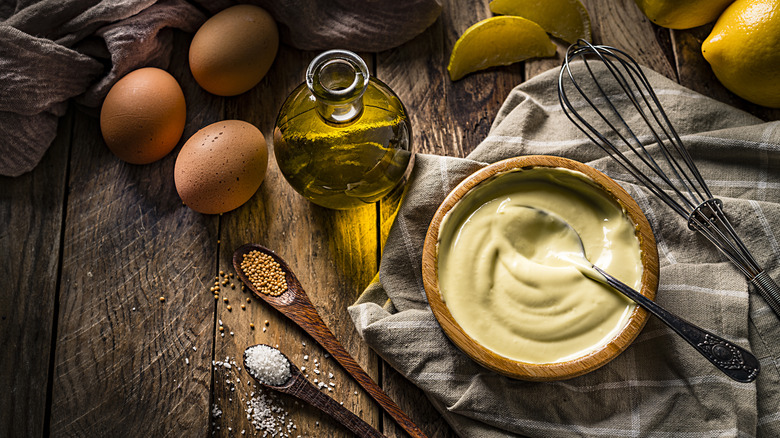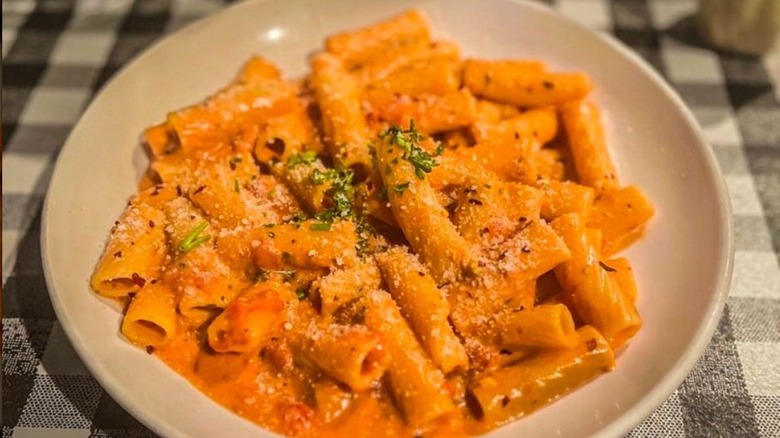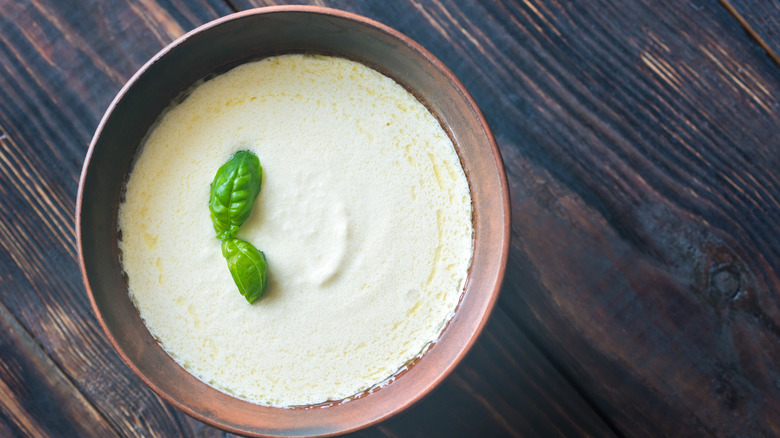11 Béchamel-Based Sauces You Should Know
We won't lie to you — French cooking is complicated, time-consuming, and requires a lot of culinary knowledge. That said, there are quite a few patterns and shortcuts to it that you may not be aware of. The French mother sauces (which include béchamel, hollandaise, espagnole, velouté, and tomato) are a great example. Every single sauce in the French cooking canon is based on one of these five sauces. By adding ingredients to a mother sauce, you can transform it into five, ten, or even a dozen other distinct sauces. That means you're well on your way to accessorizing hundreds of dishes with just a few simple tweaks.
Take béchamel for example. The standard recipe calls for a white roux (made from butter and flour), milk, salt, and nutmeg. By adding cheddar cheese to the original recipe, you can make a delectable macaroni and cheese base. Adding sautéed and puréed onions to béchamel transforms it into soubise, a sauce perfect for dressing vegetables, chicken, and eggs. There are lots more sauces you can make from this simple French mother sauce, so if you're curious to learn them all, then keep reading.
1. Cream sauce
Known as sauce crème in France, cream sauce is one of the simplest béchamel variations out there. To make it, whisk heavy cream into your béchamel base, then season with salt and pepper to taste. Give the sauce time to thicken by cooking it for an additional 10 to 15 minutes. Keep in mind, however, that this is just an estimate. You should remove the sauce from the heat as soon as it thickens. Fail to do so and you'll end up with an overly thick sauce. Once the sauce is ready, pour it over vegetables, use it with biscuits as a basic gravy, or incorporate it into a casserole. For even more visual appeal and flavor, add chopped chives or parsley.
Although this sauce looks simple on the surface, there are a number of pitfalls to be aware of when making it. As we mentioned before, prolonged cooking will create a thick, cement-like sauce that's impossible to work with. You also have to watch out for a broken sauce. If you cook the sauce too quickly or the sauce comes to a boil, the butter will separate from the liquid, resulting in a clumpy, oily mess.
2. Mornay sauce
A popular accompaniment to pasta and fish dishes, mornay sauce is made by adding cheese to a béchamel base. The classic recipe calls for the addition of nutty Gruyère and tangy Parmesan (about two ounces of each type per three and a half cups of béchamel), but this simple sauce lends itself well to experimentation. For instance, cheeses like cheddar and mozzarella work equally well and may be a better fit depending on what you're cooking.
All you have to do is to stir the cheese into the béchamel sauce and stir until it melts. That said, there are a few variations to play around with if you're feeling brave. The first involves whisking egg yolk and some nutmeg into the sauce after the cheese has melted. Alternatively, you could try adding an onion pique (aka a bay leaf attached to a peeled onion with cloves). After you've perfected your mornay sauce recipe, feel free to use it in a variety of dishes. It works just as well in baked ziti and macaroni and cheese as it does on top of nachos or scrambled eggs.
3. Soubise sauce
Named after Charles de Rohan, Prince de Soubise, this béchamel sauce variation was invented by renowned French chef, restauranter, and culinary writer Auguste Escoffier sometime in the mid-1800s. It combines creamy béchamel with savory butter-stewed onions for a flavorful sauce you have to taste to believe.
Even though soubise sauce only calls for three ingredients, it does require a bit of patience to pull off. First, you've got to chop the onions, then sauté them in butter. From there, you've got to make sure the onions are soft and translucent but be careful not to let them brown. After cooking, purée the onions in a food processor before returning them to the pot. Finally, stir the béchamel into the onions and bring the sauce to a simmer. Serve it on top of vegetables, chicken, or eggs.
Bear in mind that this is the original soubise sauce recipe. Newer versions replace béchamel with heavy cream. This swap makes preparation much easier, but be aware that it's thinner and lighter than the original version. Beyond that, you can experiment with adding unconventional ingredients like curry powder or tomato purée. Alternatively, you can try adding cooked rice as a thickener or caramelized onions to create a new flavor profile.
4. Nantua sauce
Named after Nantua, a small town in eastern France located between Lyon and Geneva, Nantua is a classic seafood sauce and one of the more unique béchamel sauce variations. It's made by combining béchamel with cream, crayfish butter, and crayfish tails. Crayfish butter and tails may sound like strange additions, but their presence makes a lot of sense when you consider Nantua's location. The commune sits on a 348-acre glacier-fed lake that's absolutely teeming with the aforementioned freshwater crustaceans.
Crayfish butter is made by combining cooked and puréed crayfish with butter. These two ingredients are then melted together and strained through a cloth. The resulting product is collected in a bowl of ice water, a crucial step that causes the butter to congeal. Once the butter has solidified enough, it's removed from the water and patted dry. This process ensures that the butter is scented with crayfish but does not contain any pieces of the animal. The crayfish butter and crayfish tails are then melted into the béchamel, resulting in a red-hued sauce that's perfect for pairing with fish and seafood dishes. In its place of origin, Nantua sauce is served with quenelles de Brochet (aka pike dumplings).
5. Cheddar cheese sauce
Like mornay, cheddar cheese sauce is a béchamel variation made by adding cheese to the original sauce. As you can probably guess from the name, this version substitutes the Gruyère and Parmesan for good old-fashioned cheddar. Although the two cheesy sauces have a lot in common, the milder flavors in the cheddar cheese variety might be more appealing to picky eaters. Similarly, it's a good option when making dishes like macaroni and cheese, lasagna, or cheesy rice as it won't compete with the other flavors.
To make it, prepare your béchamel as usual. After the sauce has thickened, turn down the heat and add nutmeg, salt, pepper, and grated sharp cheddar cheese. We recommend using about a half cup of cheese for every three and a half cups of béchamel. You can also stir in a dash of hot sauce if you want to add some kick, but leave it out if you want to keep the spice level in check. Stir the mixture until the cheese melts, and use the sauce immediately.
6. Anchovy béchamel
Thanks to their rich flavor and numerous health benefits, we're big fans of adding anchovies to recipes, and béchamel sauce is no exception. As if their complex flavor and nutritional profile weren't enough, anchovies are incredibly easy to cook with. Indeed, you can whip up this satisfying anchovy béchamel in just a few minutes.
In addition to the tiny, silvery fish, this salty and savory sauce contains garlic, thyme, mustard, vinegar, and black pepper. Once you've assembled the ingredients, toss them into a food processor and purée for about a minute (or until you obtain a homogeneous mixture). Then, heat the anchovy paste and béchamel together until warm. From there, experiment with using it as a dipping sauce for bread, a topping for fish, or as a seafood soup base. If you're feeling really adventurous, you can even try pouring a bit over a chicken breast or a steak.
7. Béchamel aux oeufs (Ecossaise)
The name of this béchamel variation translates to either béchamel with eggs or Scottish béchamel, depending on which term is used. And just as there are two names for this sauce, so too are there multiple preparation methods. For the first method, whisk three or four raw whole eggs into warm béchamel. As you might have guessed, this version pairs well with scrambled and poached eggs.
Although the second method contains similar ingredients, its form and usage are completely different. For this version, you'll need to prepare hard-boiled eggs. Once the eggs have reached your desired level of firmness (anywhere from 12 to 15 minutes), peel them and chop them up. Stir the egg pieces into béchamel and serve as a pasta sauce. Alternatively, you can use this recipe as a salad dressing by letting the ingredients cool after mixing. Another variation of the hard-boiled egg béchamel recipe involves beating two egg yolks with crème fraîche until you obtain a cream. From there, add the hot béchamel and fresh lemon juice. Serve on top of your favorite pasta.
8. Mustard sauce
Don't get us wrong — we're big béchamel fans. But have you ever noticed how this classic French sauce has a tendency to be a bit bland? One look at the ingredients list is enough to tell you why: butter, milk, and flour. Not exactly a flavor party. Luckily, it only takes one ingredient to transform your béchamel from boring to bodacious. Even better, it's an ingredient you probably have lying around the house.
So, what's the secret ingredient to this life-changing béchamel variation? Mustard, plain and simple. There are a couple of different ways to make mustard béchamel. The first is to add one teaspoon of dry mustard into the roux as they're thickening on the stove. Once the liquid is bubbling, whisk in the milk and continue making the béchamel as you normally would.
If you don't have dry mustard laying around the house, you can use Dijon mustard instead. For this option, add two tablespoons of mustard after adding milk to the roux. Whisk all of the ingredients together, then season with nutmeg, salt, and pepper. Cook the sauce for several minutes until it thickens. Like a lot of béchamel sauce variations, this one is incredibly versatile. For example, you can use it on top of fish, chicken, pork, or lamb. It's also a lovely addition to a croque monsieur sandwich.
9. Bohemienne sauce
We're not sure what this sauce has to do with a bohemian lifestyle, but we can say that it's unconventional — if only because it's served cold. This béchamel variation is made by adding egg yolks, tarragon, vinegar, olive oil, and mustard to chilled béchamel. If you're looking at the ingredients list and thinking that it sounds like béchamel with mayonnaise, you'd be right. Both sauces contain egg yolks, vinegar, olive oil, and mustard. As you might expect, it's a pretty thick sauce. That's not necessarily a bad thing, though. In fact, its smoothness and richness make it the perfect complement to chilled fish or poached salmon.
If you're looking to infuse your bohemienne sauce with even more flavor, take a cue from French master chef Auguste Escoffier. In his seminal recipe guide, "The Escoffier Cookbook: A Guide to the Fine Art of French Cuisine," Escoffier recommends adding white pepper, mignonette pepper (a blend of white and black peppercorns plus coriander), and thyme sprigs to the base.
10. Cardinale sauce
French cooking is typically pretty restrained, prioritizing simple, fresh ingredients over fancy, expensive ones. However, certain dishes throw all of that out the window and go completely hog wild with the ingredients. Nowhere is that more true than with cardinale sauce (sometimes written as cardinal sauce). This classic red-hued French sauce is made by combining béchamel with fish stock, tomato paste, sherry, truffles, cream, lobster shells (or shells from other crustaceans), and cayenne pepper. We told you it was extra.
The ingredients may sound fancy, but luckily the preparation doesn't require any special skills. You'll start by making a broth out of the chopped lobster shells, stock, and mirepoix. Once the ingredients have cooked down a bit, add some sherry and tomato paste, letting them reduce as well. Place the mixture into a food processor until you obtain a mash. Cook that with some heavy cream and shave some black truffles on top just before serving. Serve this over-the-top sauce with stuffed pasta such as ravioli, tortellini, or gnocchi.
11. Alfredo sauce
A typical alfredo sauce recipe starts with a stick of melted butter and some heavy cream. Garlic powder, salt, pepper, and Parmesan cheese are then added to the base. Once the cheese has melted and the sauce has thickened, it's time to pour this scrumptious liquid over pasta or grilled chicken.
You might think it's impossible to improve on a recipe as perfect as this one, but that's where you'd be wrong. Using béchamel as a base, you can make your alfredo that much richer and cheesier. To make this souped-up version, start by preparing béchamel sauce with an onion pique. Leave the sauce to simmer for a couple of minutes. While the sauce is thickening, cook garlic cloves and butter in a separate pan. Pour the béchamel into the pan, add some freshly ground pepper, and whisk in one cup of Parmesan cheese. Simmer for five more minutes, then pour over your favorite pasta and enjoy.
Static Media owns and operates Tasting Table.
